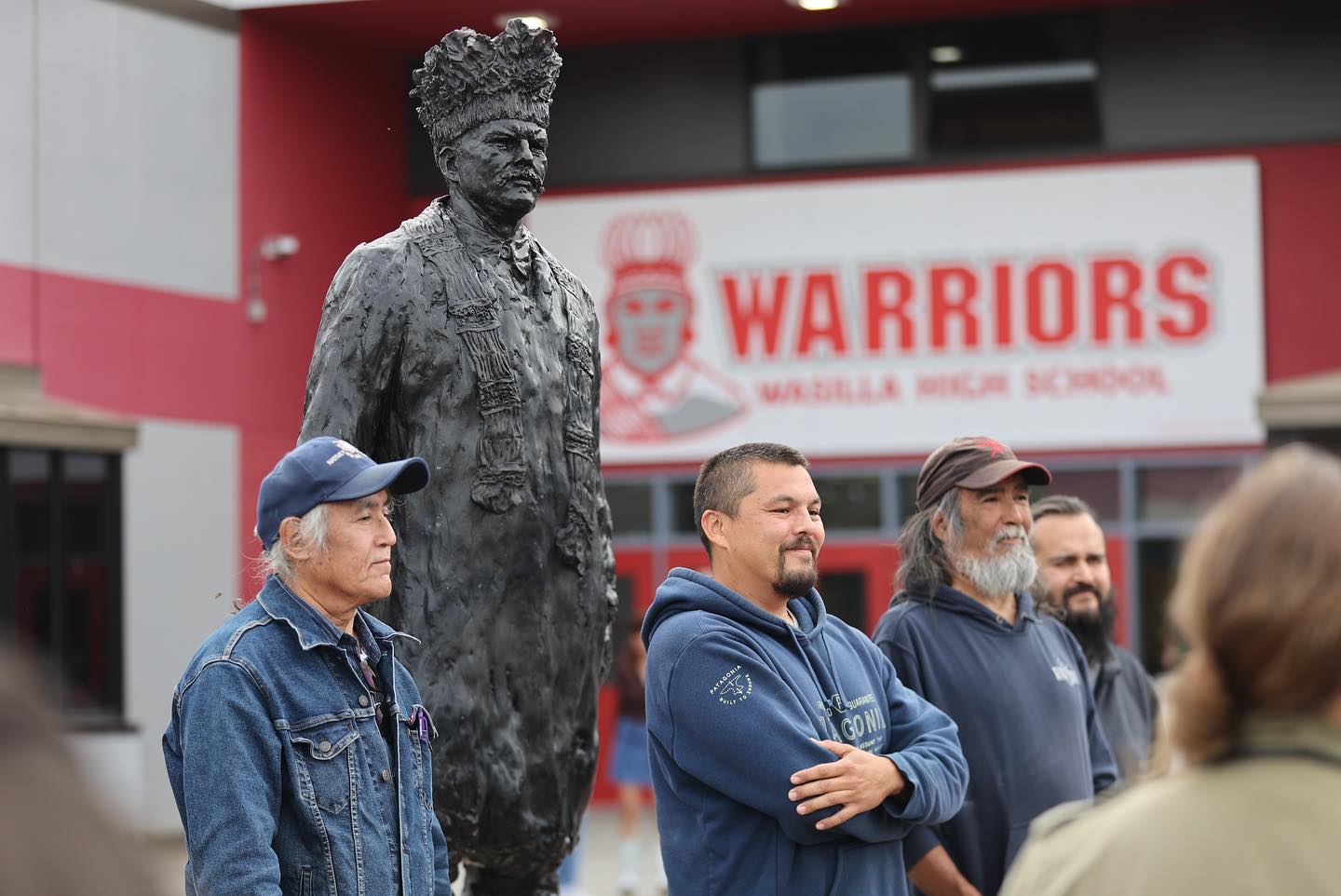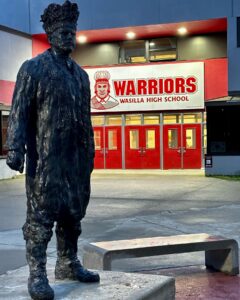Celebrating its Namesake: Wasilla High School Strengthens Community by Learning Local History

Members of the Knik Tribal Council take a photo with the new Chief Wasilla statue at Wasilla High School. KTC worked closely with the high school to ensure the legacy of Chief Wasilla was honored. Courtesy of Wasilla High School

Courtesy of Wasilla High School
Like many schools, Wasilla High School’s mascot is a Native warrior—and has been for years. In 2021, it was brought to the school’s attention that the Native warrior embodied in its mascot was not Chief Wasilla, for which the school was named. It was the image of a Lakota Sioux, a tribe that today resides in North and South Dakota, nearly 3,000 miles from Wasilla. In response, Wasilla High School embarked on a mission to learn about and honor its namesake, a respected Alaska Native chief whose ancestors and relatives today call the Mat-Su home.
Wasilla High School started its journey by reaching out to the Knik Tribal Council to explore the life of Chief Wasilla. By working with the tribe directly, the school learned about his legacy as a revered and respected local Dena’ina Athabascan leader and, in turn, helped educate the school and community about the local Dena’ina Peoples and Athabascan culture.
“I would ask students all the time, ‘Do you know the history behind Wasilla or how we got our namesake?’ No student could tell me,” said Jason Marvel, Wasilla High School principal. “There’s no local curriculum about Indigenous peoples in Alaska history courses. You don’t really have specific targeted units on just our area.” To rectify this gap, the school worked in partnership with the Knik Tribal Council to design a two-week curriculum for its Alaska history courses. Marvel says it was created “so that every single one of our students will have that access, and they will know exactly who Chief Wasilla is and why this area was named Wasilla.”
Grounded in new insights about its namesake, Wasilla High School replaced the mascot with an accurate representation of Chief Wasilla, who was revered for his strength, leadership, and cultural integrity. Partly funded by Mat-Su Health Foundation, a striking bronze statue of Chief Wasilla standing a commanding 6 feet and 5 inches tall now sits in the school’s entryway. The statue’s accompanying historical information, carefully curated by the Knik Tribal Council, sheds light on the enduring impact of Dena’ina culture on the region.
“If there is more access to knowledge about Knik Tribe’s history here, we all win. We win as residents, we win as neighbors,” said Kevin Toothaker, Knik Tribe Cultural Exchange Program administrator. The updated high school mascot and the unveiling of the statue stand as a testament to the power of collaboration and how honoring the past, embracing the present, and fostering a more culturally aware future can make us a stronger community.
“I believe our focus, as well as that of our administration team, was centered on the power of unity in high school. It’s a testament to community when diverse viewpoints converge,” said Marvel. “Our society is often divided, but it’s crucial to understand that disagreements are acceptable. By working together, we can enhance our community. This truly symbolizes the collaboration of Knik Tribal Council, Wasilla High School, Mat-Su Health Foundation and others in building a stronger, inclusive community where all perspectives are valued and represented.”
MSHF is a proud partner in this effort—and others—that broaden our understanding of the Mat-Su’s peoples and history. We are all stronger for it.
Did you know? In the Dena’ina Athabascan Indian dialect, “Wasilla” is said to mean “breath of air.” Learn more about your home and its Alaska Native heritage by going to the Wasilla High School website.
